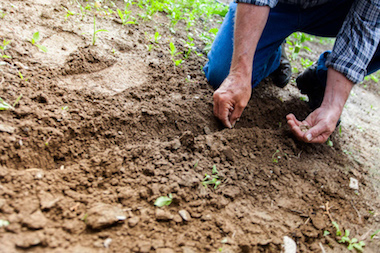
How to Start a Garden
Don't know mulch about gardening? We weren't all born with a green thumb. Learn how to start a garden with our handy gardening guide. We've harvested all the facts you need to get started, and weeded out the ones you don't. Get digging! We're rooting for
Congratulations! You’ve decided to take the step toward creating your own piece of paradise by setting up dedicated space for a garden of flowers and vegetables. You are about to join a growing number of people who enjoy getting their hands dirty.
Data shows food and flower gardening was the most popular gardening activities last year. About one out of three households participated in food gardening (36 percent) or flower gardening (34 percent).
But now you’re stumped. How do you start a garden anyway? Follow these simple step-by-step tips and you’ll be sure to be successful.
The Idea
It all starts with the vision and a dream. Whether you’re planting containers or pots on a balcony or have the luxury of a lush soil to work with, you’ll first want to decide if you want a vegetable garden or an herb garden or a flower garden or a combination of each.
A gentle warning; if you are a novice in the category, start small. It’s better to succeed just a little than fail in a grand way. For beginners, a plot three feet by three feet is a good size.
If you’re working with containers, plant no more than half a dozen good-sized pots. That's enough to provide a satisfying harvest of herbs, greens or easy vegetables while you get a feel for the amount of time and effort it takes to water and weed.
Making a Choice
Flowers or food? The choice need not be daunting.
If you choose to grow flowers, you’ll want to decide if you want annuals, which you must replant each year but which give color most of the summer…Or if you prefer perennials, which have a shorter bloom time but come back year after year. Remember, the choice is completely up to you! After all, it's your garden.
If your goal is a vegetable garden to bring fresh produce to the table, some of the most easy-to-grow for beginners are lettuce, peppers, tomatoes (the most popular homegrown vegetable), and cucumbers. With very little space, growing lettuce gives you a steady supply of wonderful salads.
Location, Location
Almost all vegetables and most flowers need about six hours of full sun each day. Spend time observing your chosen spot and watch how the sun moves across the space. It might receive more sun than you think.
But don't despair if your lot is largely sunless; many plants tolerate shade. Check plant tags or ask the staff at your local garden center to find out how much sun a plant requires.
Select a location for your garden where you simply can't ignore it. And place it close enough to a water spigot that you won't have to drag the hose clear across the yard.
The Soil
Plants live by their roots. Roots live in the soil. So, there is no denying that the soil is an intricate component of every thriving garden.
But invariably, soil needs a boost to provide healthy nutrients to your plants. Most vegetables do best in moist, well-drained soil that is rich in organic matter, such as compost or peat moss. Your local Sears garden store professional can help guide you toward the best additives and fertilizers to make your garden grow.
Since 1886 Sears has provided outstanding merchandise and quality service to customers nationwide. Their knowledge of lawn and garden supplies is well-known and respected.
(get the best deals on gardening supplies with a Sears coupon!)
The Watering Plan
For people, plants, and animals, water is the ingredient of life.
Seedlings should never dry out, so water daily while they are small. You may be able to taper off as the plants get larger.
The amount of water depends on your soil, how humid your climate is, and how often it rains. It’s best to water slowly and deeply, so the water soaks in instead of running off into the street. To minimize evaporation, water in the early morning.
And to help keep weeds out and water in, cover the soil with a couple of inches of mulch. All types are available, from pine needles to cocoa hulls to bark chips. For a vegetable garden or bed of annuals, choose a mulch that decomposes in a few months. For perennials, use a longer-lasting mulch, such as bark chips.
The Timing
As the days begin to lengthen, you are now able to spend a little more time out in the garden. In fact, March is the best time of year to start building a garden in much of the U.S. With the sun shining stronger, its warmth can be felt and the plants respond accordingly; sadly so too do the weeds so you need to make sure that you remove them before they take hold.
The goal is to have fun and take pride in your accomplishments. There's nothing like watching the whole life cycle of a plant unfold before your eyes.
Now that you know how to start a garden, you’ll quickly find out that harvesting your vegetables and picking the blooms is a rewarding experience. You’ll feel ultimate joy by surrounding yourself with flowers or dining on a salad you

